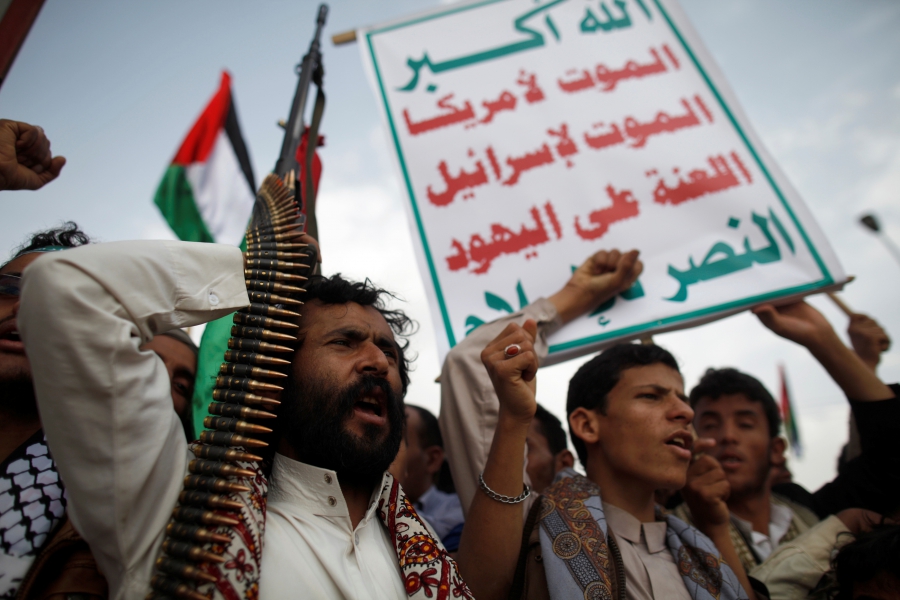When Did the War in Yemen Begin?
Over the last several days Emirati, Saudi, and Yemeni troops launched an offensive aimed at recapturing the Red Sea port city of Hodeidah. The port city, which accounts for 70 percent of imports into the country, is also a key source of income for the Houthis, a militia group that receives smuggled Iranian missiles and which has controlled the city and the port since October 2014.

Published by The Lawfare Institute
in Cooperation With

Over the last several days Emirati, Saudi, and Yemeni troops launched an offensive aimed at recapturing the Red Sea port city of Hodeidah. The port city, which accounts for 70 percent of imports into the country, is also a key source of income for the Houthis, a militia group that receives smuggled Iranian missiles and which has controlled the city and the port since October 2014. The new offensive, known as Operation Golden Victory, is only the latest and most widely-covered battle in what has been a confusing and chaotic war. Alliances disintegrate seemingly overnight and reform just as quickly; often yesterday’s enemy becomes tomorrow’s friend. But almost as complicated as determining who is fighting who in Yemen is answering what should be a very simple question: When did the war in Yemen actually begin?
A common assumption, repeated frequently by diplomats, journalists, analysts, and even the U.S. Congressional Research Service, is that the war began on March 26, 2015, when Saudi Arabia launched its air campaign, Operation Decisive Storm, which became the first stage of a larger military intervention. But that is simply not true—not from a legal perspective and not from a political one. Operation Decisive Storm marked the beginning of a new phase in the war, not the beginning of the war. In fact, Saudi Arabia, the United Arab Emirates, and the rest of their coalition partners were responding to a letter from Yemen’s internationally recognized president, Abdu Rabbu Mansour Hadi, asking for them “to provide immediate support in every form and take the necessary measures, including military intervention, to protect Yemen and its people” in an already ongoing conflict.
The war—what legal scholars call a “non-international armed conflict”—began months prior to the Saudi-led coalition’s intervention. It began even before Sanaa, Yemen’s capital, fell to the Houthis in September 2014. We argue, based on the political facts on the ground as well as existing international legal criteria, that the war in Yemen can be dated to at least as early as July 9, 2014. This is the date that Houthi forces consolidated their control over the governorate of Amran, defeated the Yemeni Military’s 310th Brigade, and overran state security and military installations. From that point forward, the Houthis and the government of Yemen have remained locked in a non-international armed conflict.
Accurately identifying when Yemen’s war began has serious legal and political implications. It affects the application of international humanitarian law, and will be necessary for a proper framework for eventual peace negotiations. The date of commencement will also be significant for any future reparations mechanisms.
The Political Facts
From June 2004 to February 2010 the Houthis fought six separate wars against the Yemeni government, the last of which involved Saudi Arabia. But what started in 2014 was something different, a new war with roots in the old ones.
After years of aerial bombardments and brutal fighting on the ground, the Houthis were after revenge, and by 2014 the Yemeni government was weak and divided enough that they could get it. Ali Abdullah Saleh, Yemen’s long-serving president of 33 years, had been forced to step down in early 2012 as a result of popular protests, leaving his vice president, Abdu Rabbu Mansour Hadi, in charge.
Even though the army had fractured and split during the Arab Spring, Saleh still retained the personal loyalty of several units. So too did Ali Muhsin al-Ahmar, a powerful general from Saleh’s own Sanhan tribe who had broken with Saleh during the protests in 2011. Ali Muhsin was also the general responsible for conducting most of the government’s wars against the Houthis from 2004 to 2010 and a key target of Houthi rage.
That was the situation in early 2014. Yemen’s military was broken, split between Hadi, the current president, Saleh, the former president, and Ali Muhsin, the country’s most powerful general. All three men were in Sanaa, and all three were jockeying for position in what was becoming a political standoff. In 2010, these men had been united in their fight against the Houthis, but in 2014 they were divided. Simultaneously but unrelatedly, the Yemeni and U.S. governments were also involved in an armed conflict against al-Qaeda in the Arabian Peninsula in Yemen.
In January 2014, with the blessing of the UN Security Council, Hadi extended his term as president for another year. A few months later, the Houthis moved out of their home governorate of Sa‘dah, where they had taken de facto control in the wake of the Arab Spring, and into the neighboring governorate of Amran. Their targets, they said at the time, were the tribal fighters and Islamists who had served as militias during the six Sa‘dah wars, not the government.
That may even have been how it started, a campaign of vengeance and score-settling, but it soon evolved into a slow-motion coup d’etat when the Houthis realized no one had the strength to stop them from taking the state. The Arab Spring broke Saleh’s regime into a handful of pieces, leaving the Houthis as one of the strongest armed groups in the country.
While their rivals faced off against one another in Sanaa, the Houthis picked off their enemies one-by-one in the highlands north of the capital. After crushing the tribal and Islamist fighters in Amran, the Houthis took on and overran the 310th Brigade, which was led by General Hamid al-Qushaybi, an ally of Ali Muhsin al-Ahmar, who had also taken part in the six Sa‘dah wars. By July 9, the Houthis had killed al-Qubayshi and captured Amran City, the capital of the governorate. They had moved beyond their area of de facto control and into a prolonged military confrontation with the government, which has continued to this day.
The Legal Criteria
International law requires that two thresholds need to be met to classify a non-international armed conflict, based on (1) the intensity of the fighting, which includes the seriousness and spread of the clashes over a period of time, the involvement of a state’s armed forces, and the use of heavy weaponry and (2) a minimum level of organization, based on five criteria, for the armed groups involved. By July 9, 2014, both of these thresholds had been met with regards to the conflict between the Houthis and the government of Yemen.
The Intensity Threshold
The fighting in Amran in June and July represented a significant increase in the intensity of the armed clashes between the Houthis and the Yemeni government, rising to the threshold of an armed conflict.
In June, the Houthis and the Yemeni government fought a series of running battles that resulted in several ad hoc ceasefire agreements, none of which held. Later that month, on June 30, the Houthis refused to hand over checkpoints and other military installations they had captured to the Yemeni government. One week later, on July 6, a Houthi spokesman claimed that their attacks had been in response to an offensive by army troops. The government of Yemen justified this advance as a response to the Houthis’ non-compliance with the ceasefire agreement at the time. Military reinforcements from Sanaa were sent to Amran on July 6, although they reportedly returned to the capital before engaging the Houthis. The Yemeni military, however, did carry out a number of airstrikes against Houthi positions in Amran.
By July 9, the Houthis had taken over the headquarters of the 310th Brigade, the Special Security Forces, the Security Department, and the Traffic Police Department in Amran, all of which were Yemeni government security installations.
Some analysts have suggested that what took place in Amran represented a conflict between the Houthis and military units allied with Ali Muhsin al-Ahmar, not between the Houthis and the Yemeni government, and therefore the war in fact started later. Their main argument is that the 310th Brigade was loyal to Ali Muhsin and not to the central government. But it is our assessment that the 310th Brigade continued to operate as a military unit under the operational control of the central government. Additionally, unlike Ali Abdullah Saleh, who lost his position as commander-in-chief when he resigned as president, Ali Muhsin retained a position in the Yemeni government both before and after the fighting in Amran.
At the same time, Hamid al-Qubayshi, the commander of the 310th Brigade, who was said to be loyal to Ali Muhsin, continued to pledge loyalty to the armed forces of Yemen until he was killed by the Houthis on or around July 8, 2014. Prior to his death he gave orders for his men to stand down, following a ceasefire agreement between the Yemeni government and the Houthis. He did this despite his own stated pledge to keep fighting. Irrespective of al-Qubayshi’s personal loyalties, he was still following the official chain of command. This, together with the military reinforcements and the airstrikes, demonstrates that the 310th Brigade was not autonomous enough to be considered an armed group under the overall control of an entity other than the government of Yemen.
Finally, two other indicators that the intensity threshold had been met in Amran were the use of heavy weaponry and the resulting effect on the civilian population. The Houthis utilized artillery and tanks and the Yemeni government resorted to a series of airstrikes. The UN reported that over 35,000 people were displaced as a result of this escalation in clashes, from the start of May 2014 to July 9.
On July 11, the Security Council called for the Houthis to withdraw and relinquish control of all military and security instillations to the government. The Security Council also noted with concern that spoilers (later identified as the Houthis) continued to stoke the conflict in the north. It is clear that by July 9, 2014, the intensity threshold for the fighting between the Houthis and Yemeni Government had been met.
The Organizational Threshold
The Houthis were already a well-organized armed group at the time of the fighting in Amran. They had fought multiple wars since 2004 and the group clearly met the standards of the five-pronged test of an armed group with the requisite minimal level of organization: presence of a command structure, organized field operations, logistical planning, military training and discipline, and a unitary structure that would allow the group to negotiate and “speak with one voice.” The Houthis had a chain of command. Its members did not act on their own but conformed “to the standards prevailing in the group” as well as being “subject to the authority of the head of the group.” The group was capable of maintaining a unified military structure, and was similarly capable of conducting large-scale operations to capture and hold territory, such as in Sa‘dah. Houthi forces could also carry out sustained and concerted military operations, as demonstrated by their resilience to the government’s airstrikes and the defeat of the 310th Brigade. And Houthi leaders had the requisite control to implement the basic obligations under Common Article 3 of the Geneva Conventions. By July 9, 2014, and for years before, the Houthis had met the organizational international law criteria for being classified as an armed group in a non-international armed conflict.
The Houthis Take Sanaa
Two months after the fighting in Amran, in September 2014, the war expanded. With the support of their old enemy, Ali Abdullah Saleh, who ordered units loyal to him to stand down, the Houthis entered Sanaa. They quickly forced the resignation of Yemen’s prime minister and defeated what was left of Ali Muhsin’s soldiers. By December, the Houthis were in control of most state institutions, and in January 2015 they placed President Hadi under house arrest, where he resigned his office. Within a few weeks, however, Hadi managed to escape Sanaa for Aden, where he retracted his resignation and then traveled to Saudi Arabia. The Houthis continued to push south from Sanaa, advancing into Taiz and later Aden, where they continued to clash with troops loyal to the Yemeni government.
In March 2015, Hadi requested military assistance from neighboring countries to continue the Yemeni government’s ongoing war against the Houthis. This request was answered by an Arab coalition led by Saudi Arabia, which began aerial bombardments of Houthi positions on March 26, 2015. The Saudi intervention expanded a war that was already well underway, and continues today.
Conclusion
There has been no real discourse on the origins of the war in the public domain. This is perhaps because conflicts in Yemen have always been mixed with multiple, localized conflicts and local, tribal, and regional tensions, which makes it very difficult to precisely identify the beginning of any one conflict and the end of another. We do not dispute that the conflict has had multiple distinct stages of evolution, each of which is symbolically and factually important—for example, the fall of Sana’a to the Houthis, the battles for Tai’zz and Aden, and now for Hodeida, the disintegration of the Houthi-Saleh alliance, and the involvement of the Saudi Arabia-led coalition. As difficult as it may be to pinpoint, the date at which the conflict began has important political, legal, and symbolic implications for both the people of Yemen and the parties to the conflict. From a legal perspective, the evidence demonstrates that the start of the war can be dated to at least July 9, 2014.




-(1).png?sfvrsn=fc10bb5f_5)

